
Bahrain Tests: Red Bull pulling away from Ferrari and Mercedes. Shocking performance for Aston Martin!
In a Formula 1 ever more dominated by simulations, every year we see a decreasing number of test days before the start of the World Championship. In fact, a large part of the workload of the teams simply shifts from the track to the simulation tools in the factory: simulators, dynos, dynamic benches, etc.
The “small” detail to consider, however, is that the 23 scheduled races will be held on track! So, irony aside, the perspective from which the teams tackled the 3 days of testing in Bahrain (and from which we’ll try to analyze the results) is to look for a correlation between the expected performance levels and those achieved at Sakhir.
2022 pole time knocked down, but how much does it count?
The absolute fastest laptime after more than 24 hours of track time was set by Sergio Perez, who set a 1'30"305 with his Red Bull RB19. This is a quicker time than the pole position (1'30"558) obtained 12 months ago on the same track by Charles Leclerc, which suggests an average improvement of the field compared to last year.
Was anyone sandbagging? ⏱
— Formula 1 (@F1) February 26, 2023
We'll find out next weekend! 🙌#F1 #F1Testing pic.twitter.com/u7go0oYcne
It makes sense then, considering the aforementioned caveats, to try and compare the best laptimes of each driver with respect to the 2022 Bahrain GP qualifying session. To reduce the number of question marks surrounding each performance, however, we will extract equivalent laptimes as functions of a single tyre compound (C3 in this case, being the compound used in last year's qualifying).
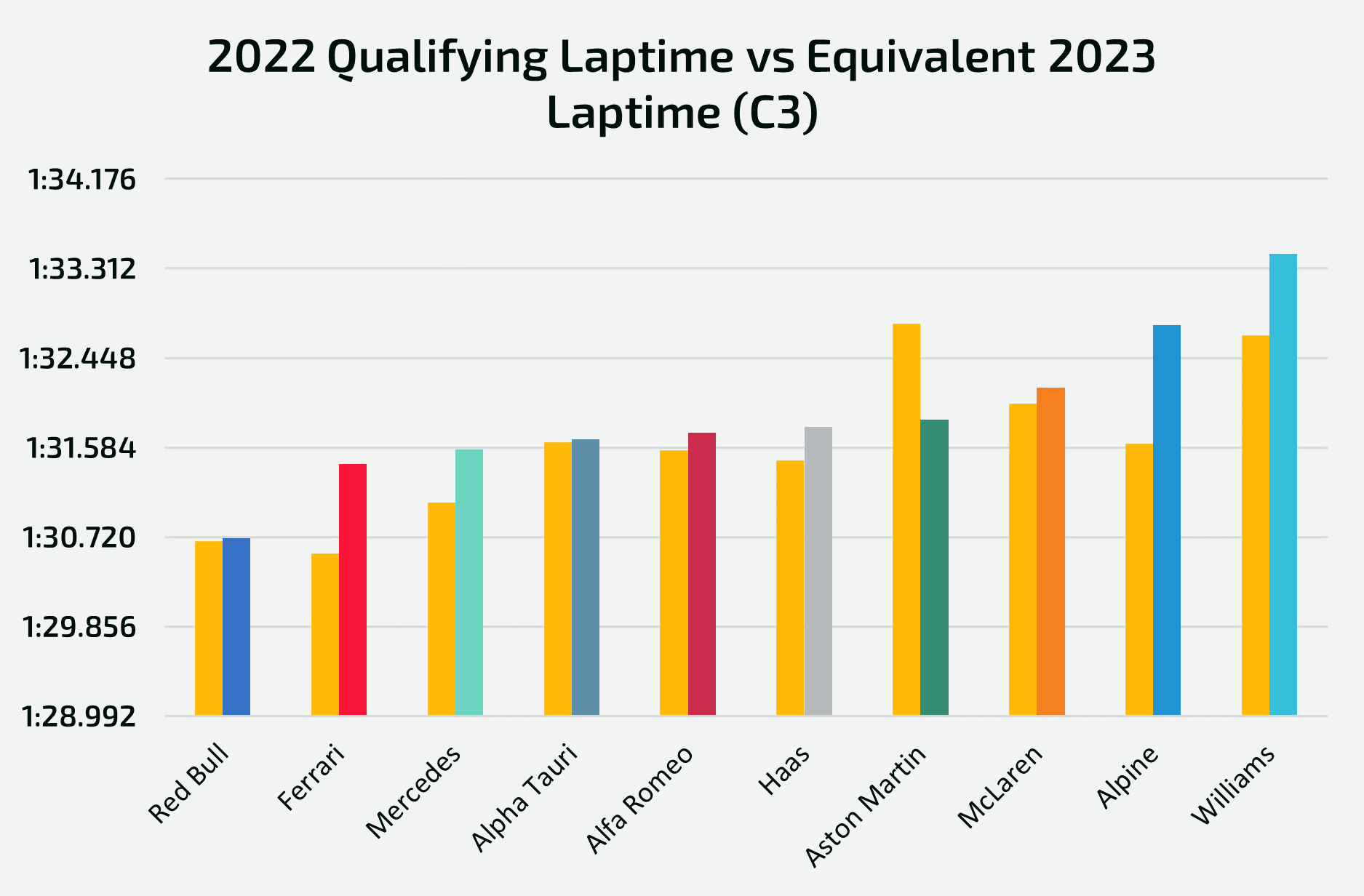
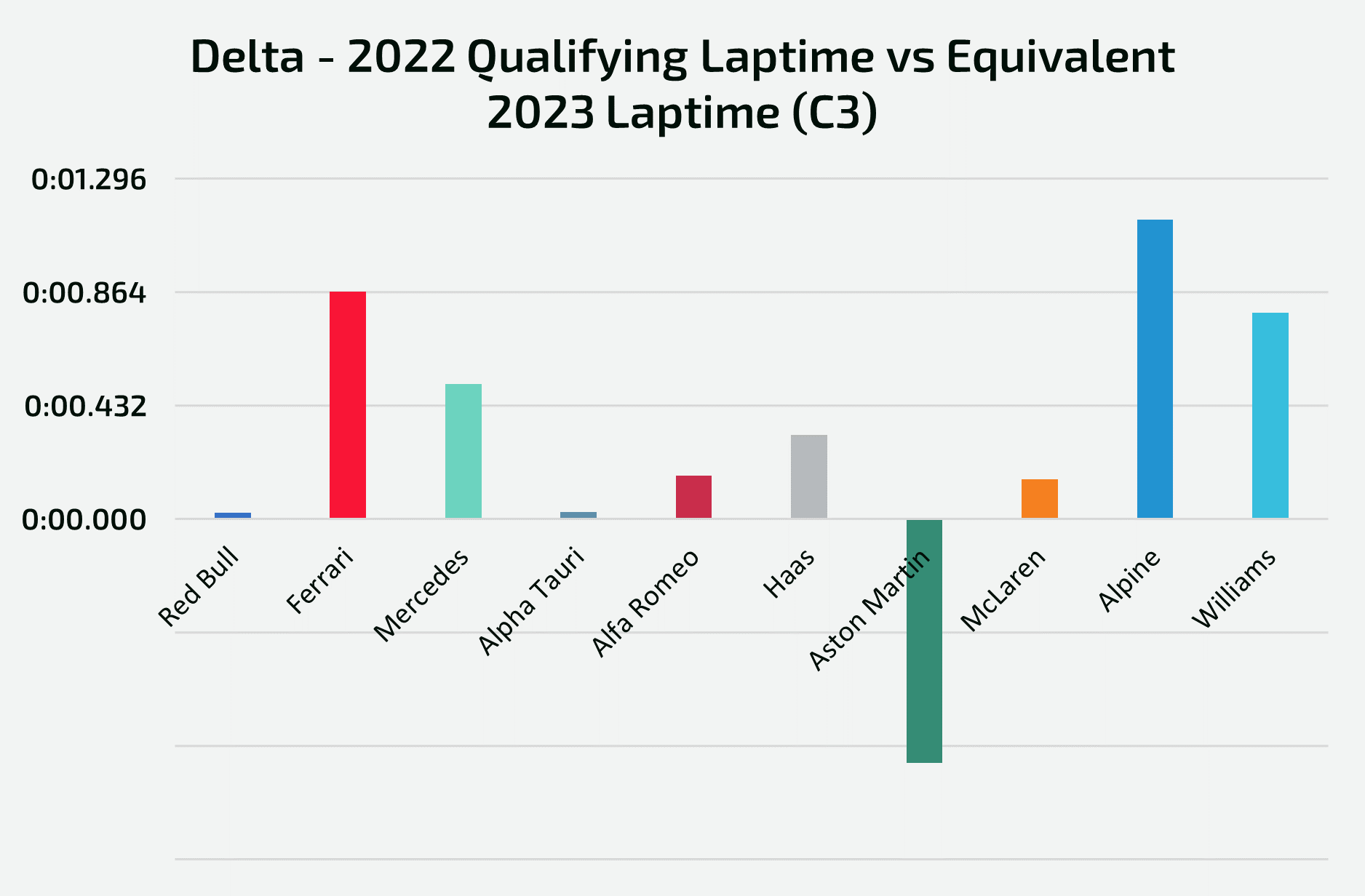
The 2023 equivalent laptimes were calculated by adding the performance deltas between the tyre compounds to the actual laptime set:
- 0.4 s/lap between compounds C3 and C4 (in favor of the latter);
- 0.5 s/lap between compounds C4 and C5 (in favor of the latter);
What we get from this is that - some more, some less - all of the teams failed to improve their 2022 times, except Aston Martin - which improved by almost 1 second!
As mentioned, the laptimes analyzed cannot have a 100% validity, given that it is very easy for the teams to exploit the Power Units in more conservative modes, or perhaps take on a higher fuel load. Why would they do this? The answer is simple: in order not to give useful indications to their direct opponents about their own performance! From this point of view, then, while taking the above best laptimes with a pinch of salt, macroscopically it can be said that the improvements put on the track by Aston Martin with its AMR23 are tangible. The car, mostly in the hands of Fernando Alonso but also of the less experienced Felipe Drugovich (who raced replacing the injured Lance Stroll), showed a very neutral behavior - little oversteer, little understeer - in various phases of the tests. This could mean that it's a well-born single-seater, i.e. aerodynamically balanced, or that the two drivers weren't pushing hard enough to let the dynamic characteristics of the AMR23 pop out. Whichever of the two possibilities is the truth, is excellent news for the Silverstone-based team.
So, having said the variables that everyone uses to confuse competitors, how can we analyze the responses of these tests?
Race simulation analysis: Red Bull is untouchable, Ferrari and Mercedes with high degradation
The type of work that can certainly be analyzed in a more truthful way is the race simulation, which on the Sakhir circuit consists of 57 laps. These laps are covered trying to carefully reproduce all the race scenarios: pit stops fitting only “race-compound” tyres, use of the DRS only if you are less than 1 second behind the car in front, battery charge management, tyre management, etc.
The only difference between the race simulations executed by each driver lies in the fact that those carried out in the morning suffer from certainly greater tyre degradation than those carried out after sunset, given that there were over 15°C difference. We remind that a Formula 1 single-seater obtains better performance in cool conditions, given that high temperatures put Power Units, mechanical parts, tyres and - last but not least - the drivers under pressure.
Having made this necessary clarification, let's compare the laptimes set in each race simulations seen in these 3 days:

First focusing our analysis on the top teams (Red Bull, Ferrari, Mercedes), we can see how the Anglo-Austrian team has extended its leadership over the other two teams: right from the first laps of the race simulation it can enjoy a rather consistent performance advantage, which translates into being able to manage tyre degradation to your liking.
Important data are missing, namely a real race simulation by Max Verstappen: the World Champion concentrated not only on "qualifying" runs but also on non-consecutive long runs... The reason why the laptimes recorded in such occasions were not included in our analysis is that, stopping for a long time in the pits at the end of each stint, the Dutch driver had the possibility to refuel from time to time, possibly distorting the responses obtained.
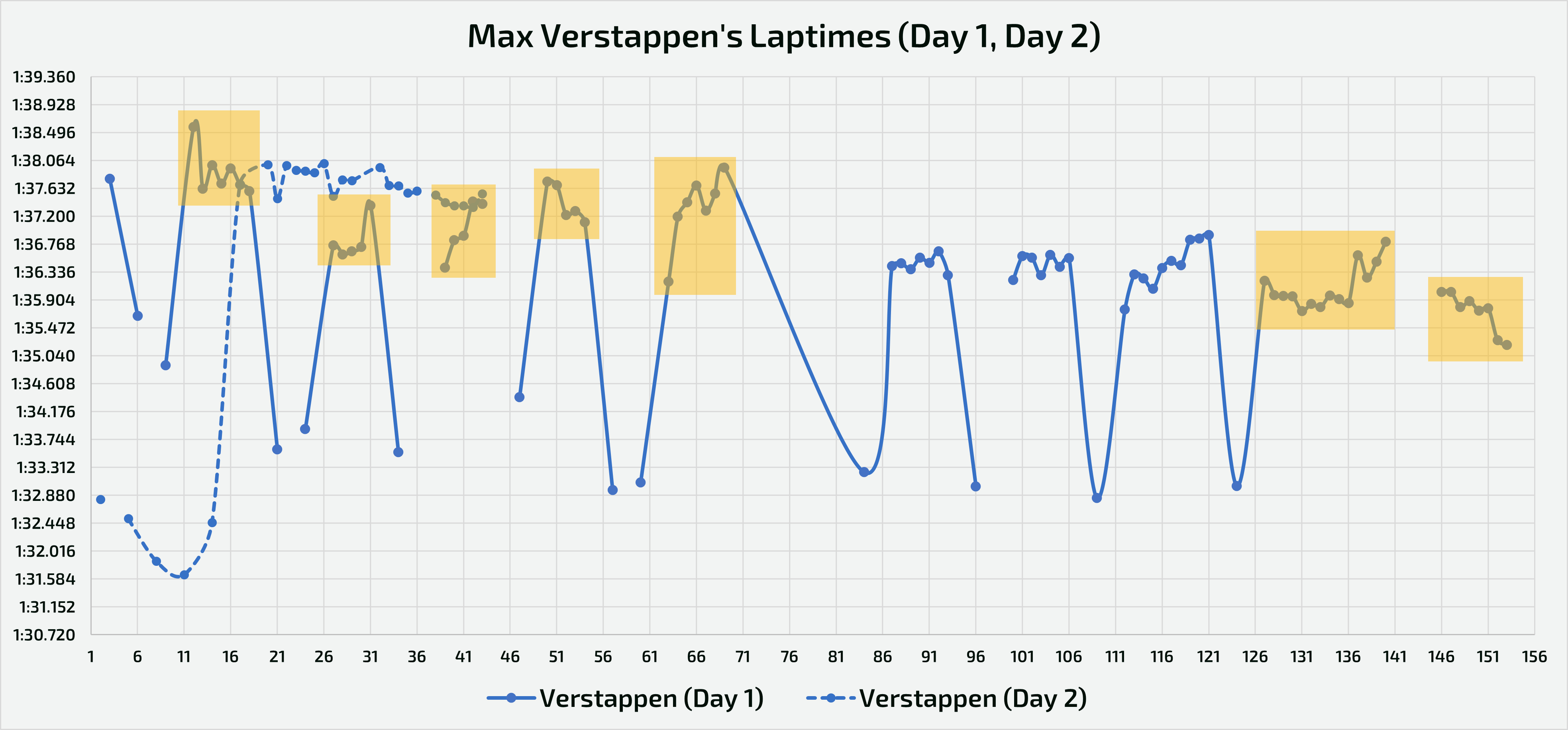
In the long runs aforementioned, however, Max kept a constant pace out of anyone else's reach: his Red Bull RB19 never needed corrections, a sign that it enjoyed an enviable aerodynamic balance, combined with a mechanical setup that made tyre degradation virtually absent. On a "rear limited" track (demanding on the rear tyres due to the frequent acceleration zones) like Sakhir, like what was said for Fernando Alonso's race simulation, this is a crucial characteristic.
Mercedes W14 🆚 Ferrari SF-23 👀#F1 #F1Testing pic.twitter.com/7mDDB1zUCs
— Formula 1 (@F1) February 23, 2023
The performance analysis of Ferrari and Mercedes goes hand in hand: although the SF-23 and the W14 are two racecars with opposite design philosophies, the various issues they faced in the test session meant that their race simulation laptimes increased dramatically as the laps went by in each stint, particularly when the two cars were fitted with C3 compound tyres. However, wanting to attribute value to low-fuel runs, the picture that emerges is that the Maranello-based team is still head and shoulders above the one from Brackley.
“They have been three intense days of work for the whole team. We analyzed the behavior of various elements on the car and ticked most of the items on our program without paying attention to laptimes or others around us, but focusing on ourselves”
Frederic Vasseur
Ferrari brought a medium downforce rear wing to Bahrain, a venue where a high downforce solution would be preferable. This, in itself, could be understood as an encouraging sign according to which the downforce generated by the SF-23 bodywork was such as to allow the Scuderia to mount a slimmer rear wing. In reality, it was immediately clear from the first day of testing that the behavior of the car was nervous, with sudden loss of grip from the rear in the sequence of turns 5-6-7 on the Sakhir track.
The situation got worse after a series of comparative tests relative to ride heights and ground clearance, when the porpoising-induced bouncing added to the "nervous" and oversteering behavior of the SF-23. To be honest, I don't see this as a particular problem, rather as the need for the engineers to build and validate the racecar's aerodynamic maps.
With aerodynamic maps we mean graphs that establish a correlation between the aerodynamic load generated and the ride heights at the front and rear of the car. Obviously, an aerodynamic map can be considered complete when it is built at all speeds: and this is what the constant-speed tests carried out from time to time on the straights are for, tests that Ferrari - like any other team - did not shy away from.
“I think this year our car has changed in some of its characteristics. I expect it to be a little faster on the straights and to struggle a little more in the corners. I can say that we are still working hard to find the car's strong point in terms of set-up. I hope there's still some margin"
Charles Leclerc
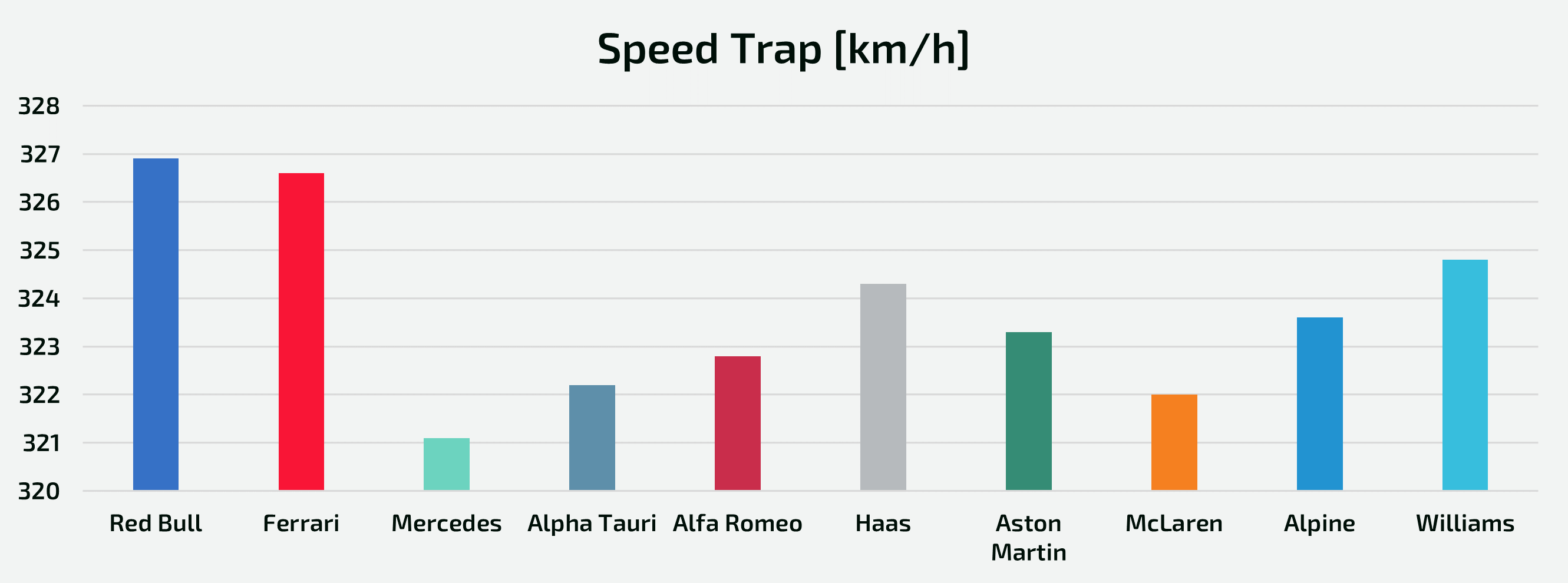
Having a medium-downforce rear wing allowed the SF-23 to run with less aerodynamic drag: this, as reported by Charles Leclerc, translated into considerably higher top speeds than those experienced with the F1-75 from 2022.
At Mercedes, the situation of Lewis Hamilton and George Russell is certainly not better! The problems of the W14 have to do with a project which, although partially following the development trend of the last W13, still seemed undeveloped. A lot of instability at the corner entry and in direction changes, and an unhealthy tendency to overheat the rear tyres also caused by a particularly stiff setup. To clarify the picture, imagine that at the end of each race simulation stint, Lewis Hamilton oversteered under acceleration which - while lying spectacular black lines on the asphalt when exiting turn 8 - suggest a rear end struggling with temperatures, which translates into a slump in performance.
"There has been a lot of discovery and the whole team has approached it with the same mentality, working hard, not being complacent and staying focused. We're not quite where we want to be but it's a good platform to start from. We don't know where we will be next week, but we will stay positive and continue to push to the maximum"
Lewis Hamilton
Added to these difficulties during the second day was a reliability issue (of a hydraulic nature) which interrupted Russell's work session prematurely - ironically, just as he was at the beginning of his important race simulation.
“On the last day we did a race simulation, with fuel for 57 laps, and we completed a real race, with pit stops and so on. Ferrari did the same program as us, simulating a complete race, and we were faster"
Fernando Alonso
The rumours from the paddock of an Aston Martin quicker than Mercedes have therefore been fully confirmed by the chronological reports of these tests, even if a big "but" remains. A large part of Alonso's good work, in fact, was the result of a suspension setup less stiff on the AMR23 than the W14’s one, with the limited tyre degradation mentioned above... If this is an advantage on rear limited circuits, the same script may not be repeated elsewhere. In other words, while waiting for confirmations, it is good to substantiate the consideration made only to the GP of Bahrain.
Alfa Romeo emerges at the top of the midfield?
The competitive order of the midfield, on the other hand, appears much more unclear: Alpine, fourth last year, did not complete a full race simulation but only isolated long runs, like Max Verstappen. McLaren also closed the triptych of days without race simulations done, but this time not by choice: the Woking team was victim of technical problems which shortened its work programme, a factor which particularly penalized Oscar Piastri - which was making his debut with the MCL60, if we exclude the brief shakedown carried out the week before the tests.

Among those who were able to fully validate their race pace, however, there are Alfa Romeo, Alpha Tauri, Haas and Williams: the trend in the performance level between these teams sees the Hinwil team with very low tyre degradation, potentially capable to complete the Grand Prix with one pit stop less, while still maintaining competitive laptimes. Among the other three contenders, no clear winner emerges, with competitiveness levels that will most likely vary along the course of the Championship, depending on the layout of each circuit and, above all, the updates they will be able to bring.
Reliability chapter: who gets an advantage?
Speaking of the issues encountered by McLaren and Mercedes, it is interesting to note how many laps were covered by each team during these tests. Completing many laps is an indication, as well as good reliability, of very compact work schedules, with the teams having to analyze the terabytes of data collected in the few days before the first GP of the year.
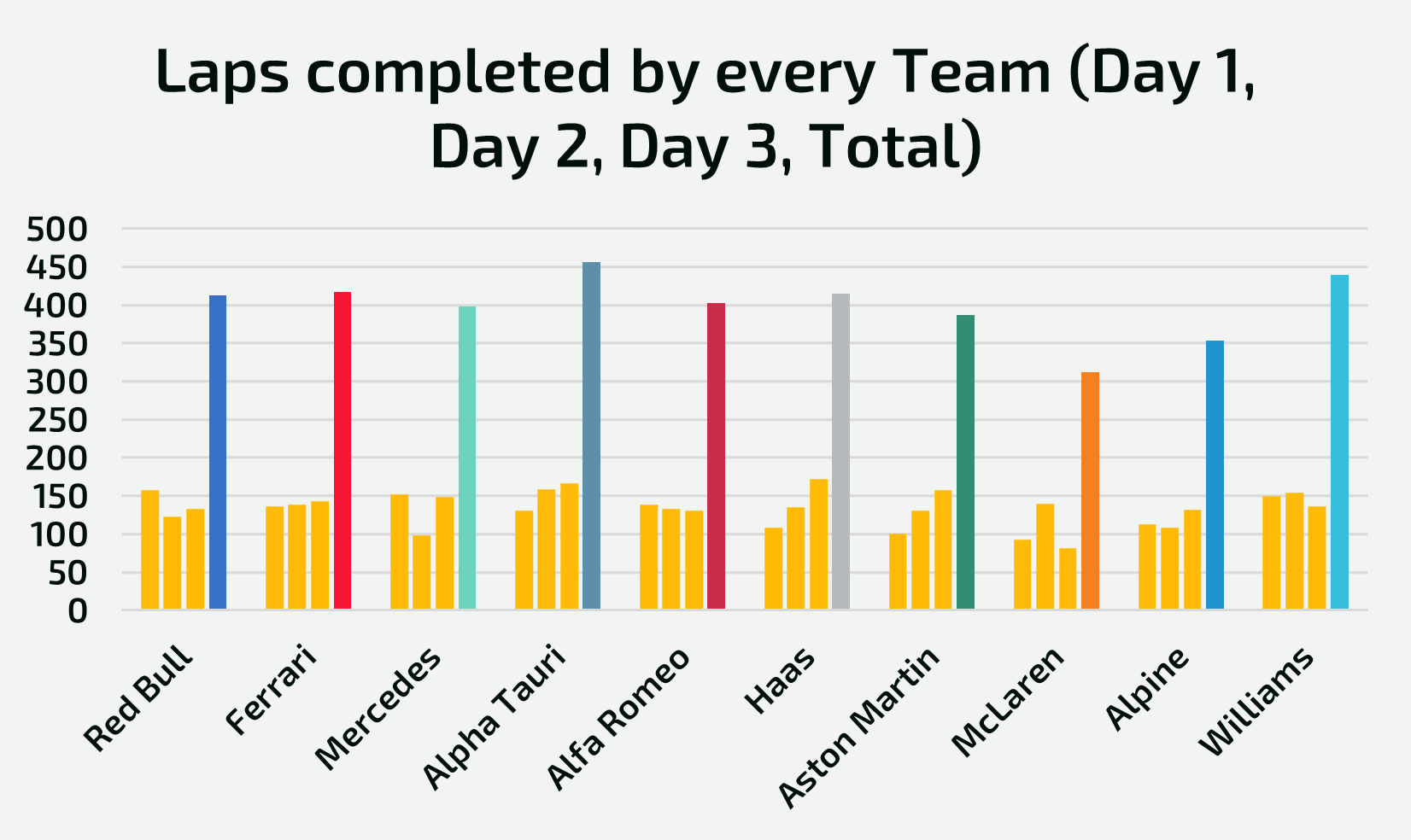
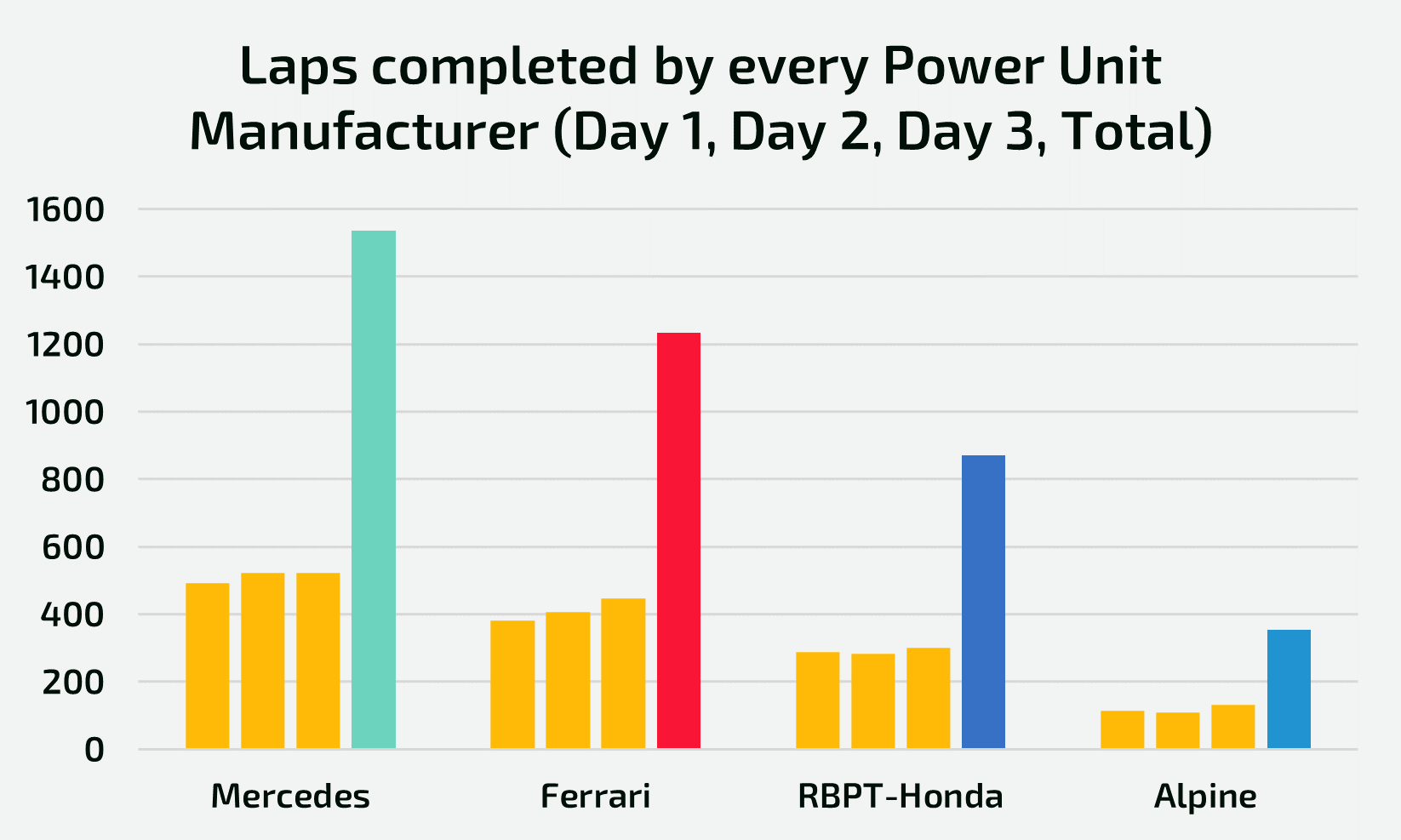
As can be seen from the first graph, the two teams that completed the fewest laps are McLaren (312) and Alpine (353). Between the two teams, surprisingly Alpine could have the biggest problem: if it is true that there are about 40 laps completed more than McLaren, it is equally true that the French team does not supply the Power Unit to any other team. In fact, as can be seen in the second graph, they will not have the possibility to fill the missing data with the information exchange that Mercedes can rely on (which, in addition to the official team, supplies its Power Unit to McLaren, Aston Martin and Williams).
Prediction: who will win the Bahrain GP?
As anticipated at the beginning of this article, it is time to collect what has been said and condense all the aspects analyzed into a hypothetical starting grid - which will not take into account the difference that the talent of each driver behind the wheel can make, but only the relative performance between the cars.
- Red Bull;
- Ferrari;
- Aston Martin;
- Mercedes;
- Alfa Romeo;
- Alpine;
- Alpha Tauri;
- Haas;
- McLaren;
- Williams;
The wait for the first Grand Prix of the year is the same as always: this Formula 1 has many doubts to clarify, but even more emotions to convey. Happy World Championship to all, and may the best one win!
Index
Bahrain Tests: Red Bull pulling away from Ferrari and Mercedes. Shocking performance for Aston Martin!